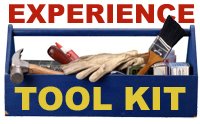Experience Toolkit: The Power of Persona
 Imagine with me for a minute that you're on a charge to make your company, or your product, or your web site increasingly customer centric. So you have a company-wide kickoff to rally passion around the customer.
Imagine with me for a minute that you're on a charge to make your company, or your product, or your web site increasingly customer centric. So you have a company-wide kickoff to rally passion around the customer."We need to better serve our customer and be more customer centered," says Joe the CEO. "To do this we're going to..."
…and Joe then rattles off a list of initiatives like retooling the customer database, increasing call center resolution by 6%, reducing churn by 20% and redesigning the self-service web site.
I can't tell you how many of these meetings I've been in. While they’re often informative, they fall flat in rallying the troops because in the end, they're about tasks, not about the customer. They fail to unite individuals around real people and a common set of goals that will help service those people, and instead focus individuals on operational activity.
To rally an organization around the customer, it’s a good idea to make some introductions. In an increasingly complex world of demographic, psychographic and ethnographic research, it’s no longer safe to assume that your employees actually know your customers. When rallying the troops, getting back to basics and keeping it simple can be powerful. One of the best ways to do this is to harness the power of persona.
My friend, Kelly Goto has been preaching the power of persona for more than a decade, specifically highlighting power of their use pertaining to web design. Kelly and I frequently work together, and for years we've been harnessing customer personas to develop a clear picture of the type of audience we're designing for. They work for web sites, products, brick and mortar store experiences, marketing campaigns … you name it. The results are great – and they’re effective in uniting diverse work teams around a set of customer-centric objectives. All tasks and activities are then tooled around customer goals.
So what's a persona?
A persona is essentially a representative profile, which summarizes a key demographic target. It is usually accompanied by a photograph of a representative customer who is given a "real name" and assigned some basic demographic data (such as age, marital status, tangible occupation and income) as well as relevant information pertaining to personal behavior. Personas represent the "real face" of a customer and make it easier to unite groups of people around the customer base. There are usually a number of customer personas for any given project.
The use of personas, along with the method of validating our designs with real customers in an iterative manner across the design lifecycle is a powerful way to unite and rally staff members around customers and guide activities (design, production, laungh) effectively. .
Taking personas a next step we also recommend the development of "customer scenarios." These describe, in further detail, the needs, behaviors, preferences and requirements that will fuel the development of customer experience. Customer scenarios essentially describe the optimal experience the customer should have, and can be used to drive the development process - and as a reality check during testing. They're highly effective for uniting the diverse teams charged with developing customer experience. Here's an abbreviated sample from Kelly's best-selling book, "Web Re-Design: Workflow that Works.":
One company that has done a great job of utilizing customer personas for “telling the story” of its customers is Best Buy. There are a ton of articles describing how the stores have been retooled to meet the needs of customers like "Barry", "Buzz" and "Jill". The early results are in and highly promising. We'll talk a little more about how this is going, and how it is changing the business - and customer relationships in a tangible way in future posts.
Subscribe to:
Post Comments (Atom)
FAVORITES
- On Trust & Influence
- Don't be Social Media Sharkbait
- The Social Media Engagement Continuum
- 10 Tips for Twitter Unmarketing
- Five Experience Funamentals
- Experience & Branding: The Three Word Rule
- Get Some Experience Healing!
- Discovering Customer Experience Pitfalls
- Not My Job: The CX Enemy
- Shoe Carnival: Watch Out for Carnies!
- Bathroom Usability
RECENT COMMENTS
SEARCH
LEIGH DURST

I’m Leigh Durst, a 20 year veteran in business, operations, customer strategy, ecommerce, digital & social media and marketing. Simply put, I’m a strategist that helps companies (start-up to blue chip) achieve business shift, create more compelling online and offline experiences. I also write, speak and teach about experience design and next-generation business. I’m a futurist, visionary, strategist, doer and connector with a passion for people and helping others. When I’m not on the road, you’ll find me in the San Francisco bay area, working, beaching it and hanging out with my family and dog.
Labels
Best Practices
CX
Community
Content
Copy writing
Customer Experience Leaders
Customer Relationship Management
Defining Customer Experience Management
Ethics
Group Think
Harassment
Innovation
Plagiarism
Plurk
RESOURCES
Social Media
Social Media Expert
Twitter
UX
Web 2.0
Web Strategy
advertising
air travel
bank experience
bathrooms
branding
brick and mortar retail
charlene li
cottonelle
customer centricity
customer experience
customer experience files
customer experience management
customer experience pitfalls
customer experience; innovation;
customer research
economy
experience best practices
experience file
experience pitfalls
good customer experience
infrastructure
life
marketing
marketng
motherhood
old navy
personal
privacy
reinvention
restaurant experience
retail experience
security
social networking
starbucks
stuck
target
toilet paper
trust agents
trust continuum
usability best practices
user experience
user experience
word-of-mouth




0 comments:
Post a Comment